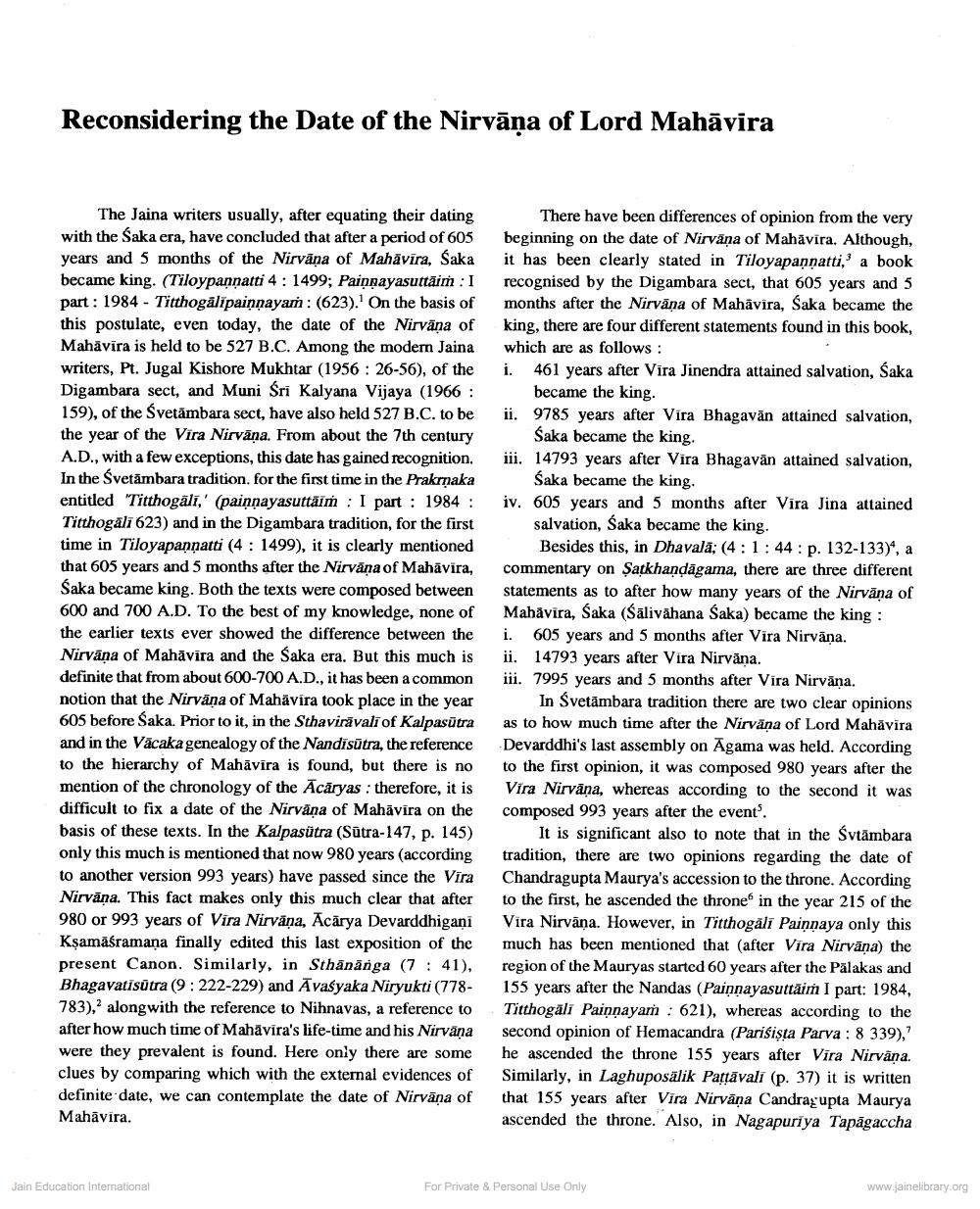Book Title: Reconsidering Date Of Nirvana Of Lord Mahavira Author(s): Sagarmal Jain Publisher: Z_Jaina_Literature_and_Philosophy_a_Critical_Approach_001936_HR.pdf View full book textPage 1
________________ Reconsidering the Date of the Nirvāņa of Lord Mahāvira The Jaina writers usually, after equating their dating with the Saka era, have concluded that after a period of 605 years and 5 months of the Nirvana of Mahāvīra, Saka became king. (Tiloypannatti 4 : 1499; Painnayasuttaim :I part: 1984 - Titthogālipainnayaṁ: (623). On the basis of this postulate, even today, the date of the Nirvana of Mahävira is held to be 527 B.C. Among the modern Jaina writers, Pt. Jugal Kishore Mukhtar (1956 : 26-56), of the Digambara sect, and Muni Sri Kalyana Vijaya (1966 : 159), of the Svetämbara sect, have also held 527 B.C. to be the year of the Vira Nirvāna. From about the 7th century A.D., with a few exceptions, this date has gained recognition. In the Svetămbara tradition, for the first time in the Prakraka entitled "Titthogāli,' (paiņnayasuttaim : I part : 1984 : Titthogāli 623) and in the Digambara tradition, for the first time in Tiloyapannatti (4 : 1499), it is clearly mentioned that 605 years and 5 months after the Nirvana of Mahavira, Saka became king. Both the texts were composed between 600 and 700 A.D. To the best of my knowledge, none of the earlier texts ever showed the difference between the Nirvana of Mahavira and the Saka era. But this much is definite that from about 600-700 A.D., it has been a common notion that the Nirvana of Mahävira took place in the year 605 before Saka. Prior to it, in the Sthaviravali of Kalpasūtra and in the Vacaka genealogy of the Nandisutra, the reference to the hierarchy of Mahavira is found, but there is no mention of the chronology of the Acāryas : therefore, it is difficult to fix a date of the Nirvana of Mahāvira on the basis of these texts. In the Kalpasutra (Sūtra-147, p. 145) only this much is mentioned that now 980 years (according to another version 993 years) have passed since the Vīra Nirvana. This fact makes only this much clear that after 980 or 993 years of Vira Nirvāņa, Ācārya Devarddhigani Kşamāśramana finally edited this last exposition of the present Canon. Similarly, in Sthānanga (7 : 41), Bhagavatīsūtra (9:222-229) and Āvasyaka Niryukti (778- 783), alongwith the reference to Nihnavas, a reference to after how much time of Mahāvīra's life-time and his Nirvāņa were they prevalent is found. Here only there are some clues by comparing which with the external evidences of definite date, we can contemplate the date of Nirvana of Mahāvira. There have been differences of opinion from the very beginning on the date of Nirvāņa of Mahavira. Although, it has been clearly stated in Tiloyapannatti, a book recognised by the Digambara sect, that 605 years and 5 months after the Nirvāṇa of Mahavira, Saka became the king, there are four different statements found in this book, which are as follows: i. 461 years after Vira Jinendra attained salvation, Saka became the king. ii. 9785 years after Vira Bhagavān attained salvation, Saka became the king. iii. 14793 years after Vira Bhagavān attained salvation, Saka became the king. iv. 605 years and 5 months after Vira Jina attained salvation, Saka became the king. Besides this, in Dhavalā; (4:1:44: p. 132-133), a commentary on Sackhandagama, there are three different statements as to after how many years of the Nirvana of Mahavira, Saka (Salivahana Saka) became the king : i. 605 years and 5 months after Vira Nirvāna. ii. 14793 years after Vira Nirvana. iii. 7995 years and 5 months after Vira Nirvana. In Svetāmbara tradition there are two clear opinions as to how much time after the Nirvana of Lord Mahăvira Devarddhi's last assembly on Agama was held. According to the first opinion, it was composed 980 years after the Vira Nirvāna, whereas according to the second it was composed 993 years after the event. It is significant also to note that in the Sytämbara tradition, there are two opinions regarding the date of Chandragupta Maurya's accession to the throne. According to the first, he ascended the throne in the year 215 of the Vira Nirvāna. However, in Titthogali Painnaya only this much has been mentioned that (after Vira Nirvāna) the region of the Mauryas started 60 years after the Palakas and 155 years after the Nandas (Painnayasuttäiṁ I part: 1984, Titthogāli Painnaya : 621), whereas according to the second opinion of Hemacandra (Parisista Parva : 8 339),' he ascended the throne 155 years after Vira Nirvana. Similarly, in Laghuposalik Pattāvali (p. 37) it is written that 155 years after Vira Nirvana Candragupta Maurya ascended the throne. Also, in Nagapuriya Tapägaccha Jain Education International For Private & Personal Use Only www.jainelibrary.orgPage Navigation
1 2 3 4 5 6 7 8 9
